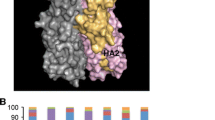Abstract
Influenza A viruses possess two surface glycoproteins, hemagglutinin (HA), which binds to sialic-acid-containing receptors, and neuraminidase (NA), which removes sialic acid from host cells. It is well established that the HA-NA functional balance regulates the efficiency of virus replication. Here, we selected a plaque variant of the WSN (H1N1) strain that grew better than the wild-type virus in NA-expressing MDCK cell culture. A reverse genetics study revealed that the single mutation HA E190K, which occurs infrequently in naturally isolated H1N1 viruses, was responsible for the phenotype of this variant. Receptor assays indicated that this mutation did not affect the receptor specificity of HA but enhanced its receptor-binding affinity, resulting in altered HA-NA functional balance relative to that of the wild-type virus. We also found that this variant replicated in nasal turbinates at an equivalent level but in lungs at a lower level compared with wild-type virus, demonstrating its attenuation in mice. Together, our data demonstrated the importance of the HA-NA functional balance for influenza virus replication in an in vivo biological setting.








Similar content being viewed by others
References
Chen H, Wen X, To KK, Wang P, Tse H, chan JF, Tsoi HW, Fung KS, Tse CW, Lee RA, Chan KH, Yuen KY (2010) Quasispecies of the D225G substitution in the hemagglutinin of pandemic influenza A(H1N1) 2009 virus from patients with severe disease in Hong Kong, China. J Infect Dis 201:1517–1521
Francis T, Moore AL (1940) A study of the neurotropic tendency in strains of the virus of epidemic influenza. J Exp Med 72:717–728
Gamblin SJ, Skehel JJ (2010) Influenza hemagglutinin and neuraminidase membrane glycoproteins. J Biol Chem 285:28403–28409
Horimoto T, Kawaoka Y (2005) Influenza lessons from past pandemics, warnings from current incidents. Nat Rev Microbiol 3:591–600
Hughes MT, Matrosovich M, Rodgers ME, McGregor M, Kawaoka Y (2000) Influenza A viruses lacking sialidase activity can undergo multiple cycles of replication in cell culture, eggs, or mice. J Virol 74:5206–5212
Hughes MT, McGregor M, Suzuki T, Suzuki Y, Kawaoka Y (2001) Adaptation of influenza A viruses to cells expressing low levels of sialic acid leads to loss of neuraminidase activity. J Virol 75:3766–3770
Ito T, Suzuki Y, Mitnaul L, Vines A, Kida H, Kawaoka Y (1997) Receptor specificity of influenza A viruses correlates with the agglutinin of erythrocytes from different animal species. Virology 227:493–499
Ito T, Suzuki Y, Takada A, Kawamoto K, Otsuki K, Masuda H, Yamada M, Suzuki T, Kida H, Kawaoka Y (1997) Differences in sialic acid-galactose linkages in the chicken egg amnion and allantois influence human influenza virus receptor specificity and variant selection. J Virol 71:3357–3362
Jin H, Lu B, Zhou H, Ma C, Zhao J, Yang CF, Kemble G, Greenberg H (2003) Multiple amino acid residues confer temperature sensitivity to human influenza virus vaccine strain (FluMist) derived from cold-adapted A/Ann Arbor/6/60. Virology 306:18–24
Liu Y, Childs RA, Matrosovich T, Wharton S, Palma AS, Chai W, Daniels R, Gregory V, Uhlendorff J, Kiso M, Klenk H-D, Hay A, Feizi T, Matrosovich M (2010) Altered receptor specificity and cell tropism of D222G hemagglutinin mutants isolated from fatal cases of pandemic A(H1N1) 2009 influenza virus. J Virol 84:12069–12074
Matrosovich M, Tuzikov A, Bovin N, Gambaryan A, Klimov A, Castrucci MR, Donatelli I, Kawaoka Y (2000) Early alterations of the receptor-binding properties of H1, H2, and H3 avian influenza virus hemagglutinins after their introduction into mammals. J Virol 74:8502–8512
Medeiros R, Escriou N, Naffakh N, Manuguerra J-C, van der Werf S (2001) Hemagglutinin residues of recent human A(H3N2) influenza viruses that contribute to the inability to agglutinate chicken erythrocytes. Virology 289:74–85
Mitnaul LJ, Matrosovich M, Castrucci MR, Tuzikov AB, Bovin NV, Kobasa D, Kawaoka Y (2000) Balanced hemagglutinin and neuraminidase activities are critical for efficient replication of influenza A virus. J Virol 74:6015–6020
Mochalova L, Kurova V, Shtyrya Y, Korchagina E, Gambaryan A, Belyanchikov I, Bovin N (2007) Oligosaccharide specificity of influenza H1N1 virus neuraminidases. Arch Virol 152:2047–2057
Neumann G, Watanabe T, Ito H, Watanabe S, Goto H, Gao P, Hughes MT, Perez DR, Donis R, Hoffmann E, Hobom G, Kawaoka Y (1999) Generation of influenza A viruses entirely from cloned cDNAs. Proc Natl Acad Sci USA 96:9345–9350
Smith W, Andrews CH, Laidlaw PP (1933) A virus obtained from influenza patients. Lancet 2:66–68
Totani K, Kubota T, Kuroda T, Murata T, Hidari KI, Suzuki T, Suzuki Y, Kobayashi K, Ashida H, Yamamoto K, Usui T (2003) Chemoenzymatic synthesis and application of glycopolymers containing multivalent sialyloligosaccharides with a poly(l-glutamic acid) backbone for inhibition of infection by influenza viruses. Glycobiology 13:315–326
Wagner R, Matrosovich M, Klenk H-D (2002) Functional balance between haemagglutinin and neuraminidase in influenza virus infections. Rev Med Virol 1:159–166
Wagner R, Wolff T, Herwig A, Pleschka S, Klenk H-D (2000) Interdependence of hemagglutinin glycosylation and neuraminidase as regulators of influenza virus growth: a study by reverse genetics. J Virol 74:6316–6323
Yen HL, Liang CH, Wu CY, Forrest HL, Ferguson A, Choy KT, Jones J, Wong DD, Cheung PP, Hsu CH, Li OT, Yuen KM, Chan RW, Poon LL, Chan MC, Nicholls JM, Krauss S, Wong CH, Guan Y, Webster RG, Webby RJ, Peiris M (2011) Hemagglutinin-neuraminidase balance confers respiratory-droplet transmissibility of the pandemic H1N1 influenza virus in ferrets. Proc Natl Acad Sci USA 108:14264–14269
Acknowledgments
We thank Dr. Emi Takashita and Susan Watson for providing anti-NA antibody and editing the manuscript. This work was supported by grants-in-aid for Specially Promoted Research and for Scientific Research (B), from the Ministry of Education, Culture, Sports, Science, and Technology, by grants-in-aid from the Ministry of Health, Labor and Welfare, by ERATO, and by National Institute of Allergy and Infectious Diseases Public Health Service research grants.
Conflict of interest
The authors declare that they have no conflicts of interest
Author information
Authors and Affiliations
Corresponding author
Rights and permissions
About this article
Cite this article
Gen, F., Yamada, S., Kato, K. et al. Attenuation of an influenza A virus due to alteration of its hemagglutinin-neuraminidase functional balance in mice. Arch Virol 158, 1003–1011 (2013). https://doi.org/10.1007/s00705-012-1577-3
Received:
Accepted:
Published:
Issue Date:
DOI: https://doi.org/10.1007/s00705-012-1577-3



